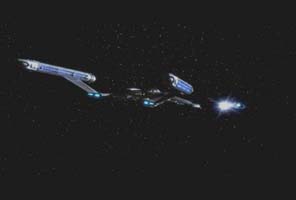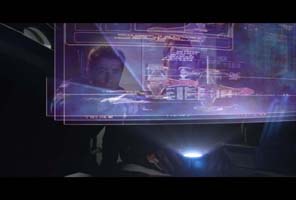|
Since
its first appearance, in the 60s, Star Trek has continues
to set the pace for science fiction shows. As the franchise
has evolved it has continued to break new barriers. Its core
post-production team has been with Trek from anywhere
between 5-20 years, and have seen the special effects progress
from physical models to computer generated (CG) ships and
effects. Keri Allan talks to the some of the people working
behind the scenes as they begin work on season two of Enterprise...
Set in the 22nd Century, Enterprise predates the enigmatic
Kirk and his crew, but still leaves room for high tech CGI
wizardry, creating space ships, aliens and backgrounds never
seen before.
Artists have already had to cope with space anomalies, morphing
aliens and a temporal cold war - allowing for a future post-apocalyptic
setting for the end of season one.
Working
in-house the team is run by Dan Curry [pictured right], visual
effects producer, who oversees the two separate CGI teams
headed by visual effects supervisors Mitch Suskin and Ron
Moore. The episodes are divided in two - one team taking on
the 'odds' and the other the 'evens'. They then oversee the
main CG work, which was created last year at Foundation Imaging
and, from season two onwards, at Eden Effects. Other, mainly
2D effects, such as warp stars in the background, phaser fire
and transporter graphics are created by Technicolor Creative
Services.
Over
the many years of its existence, CGI has been the biggest
step forward for Trek. "I have been involved in the
production of visual effects for over 25 years, and for me
CGI has been the most profound technical advance during this
period," says Suskin. "It's hard to appreciate the significance
of computer generated effects if you didn't work in the period
before their development. It took weeks and sometimes months
to complete shots. With the advent of computer graphic tools,
a single artist can have complete technical and creative oversight
on a shot, and can complete an effect in days or hours instead
of weeks. This was never possible with model photography and
optical compositing."
 |
It
wasn't all plain sailing during the transition however, and
some were reluctant to change. "At first I think it was harder
for us as we used to prefer the look of models and shoot in
motion control," says Moore. "But we were limited to the kinds
of shots we could do. There were some moves we just didn't
have time to work out using motion control, due to limitations
of the model size or camera. With CG that's just not the case.
We can throw in hundreds of ships, and we can do moves that
we could never do with motion control.
Moore continues: "I think we were reluctant to go to CGI,
we didn't think it was good. We had tried it, way back in
early Next Generation episodes and it just didn't
work very well. Occasionally over the years we'd try it here
and there just to do something, but it took time for that
to grow. I think it took a while for the quality of the CG
images to match the originals."
Curry
adds: "CGI is both a godsend and a drawback - one of the things
that is taken away is the kind of alchemy of figuring out
how to use materials that were never intended to be used that
way - to have the illusion of being something else. Where
in the CG world - especially for ships - it's a godsend because
it saves us from 60 hours a week of shooting miniatures."
Some
team members have taken a leap into the world of CG. Rob Bonchune
is now supervising VFX animator at Eden, but began working
on Trek five years ago as a practical miniature, model
and prop maker. He's now left behind the glue and the workshop
in favour of Lightwave and a PC. He was thrown in at the deep
end when for his first supervisory role on Voyager
he was asked to crash the ship onto an ice planet and given
two weeks to make it happen.
Nowadays,
supervised by Suskin, 99 per cent of the time Bonchune's team
uses Lightwave to create effects. They've shown that many
feats are possible using this simple tool, and that you don't
always need expensive software to create the best effects.
Recently,
they've also brought onboard After Effects to speed up rendering,
and now use a technique evolved from model filming. "When
we're running short on time we render up separate elements,
kind of like old school motion control where you're filming
space separately and putting everything together," says Bonchune.
"The reason we do that is that each separate element will
render faster with the stack of machines we have and then
if the producers want us to change anything it will be easier
and quicker to re-render one element than to re-render the
whole shot."
 |
Eden
also has an unorthodox, yet cost saving method of running
a render farm. "With Eden Effects they rent what they need,"
Bonchune explains. "When I worked at Foundation Imaging the
machines were bought and we had roughly 150. Eden's philosophy
is more like rent what you need. Therefore as soon as a better
chip comes along you get rid of what you have and you get
the newest one in. So when we were trying to deliver a show
in a ridiculously short amount of time they brought in an
extra 40 machines and it made a difference to how quickly
we got it done, but on average I'd say there's 50 machines."
With
Enterprise there are no models, not even a visual model
for the ship except for a paper version created in order to
envision how certain shots might work. "I guess in a sense
it is a precedent, Voyager being the last one to use
practicals, even though they went away from them in the end,"
notes Bonchune. "This show is all CGI. We built a CG
version of a real ship, with the difference being in the small
details. You can sit on the hull on certain parts of the ship.
You can keep a camera flying in so you can see writing on
small panels on the cargo doors. If it was a filming miniature,
you could never do that."
Many
new alien races have also been brought into the show and their
abilities enhanced using CG. Motion capture technology has
allowed for convincing physical contortions of the villainous
Suliban race, for example.
Supervising
artist, John Teska said: "We did a cyberscan, so the actual
building of the character and the texturing were relatively
easy to do the climbing of the walls. It got a lot more complicated
for the 'squishing under the door' shots! A lot of that was
just manipulation by re-sculpting morph - targets and using
the bones and such as reference."
Bonchune
adds: "What's really amazing to me is the use of motion capture.
There's one scene that Teska did where live action Sulibans
are walking down a corridor, Teska added two more crawling
on the walls. You can't tell the difference! You just couldn't
do that four years ago without extreme difficulty, but now
we can do it on a much more consistent and regular basis."
Set
extensions are also the mainstay of Enterprise, bridging
the gap between the grand illusion of space and the physical
sets upon which the actors deliver their lines.
There
are also other things such as Nebula's etc. This is when they
call in the specialists such as NASA and the JPL (Jet Propulsion
Laboratory) who provide them with deep space photographs from
the Hubble telescope. "We
will paint out the stars so we can put in our own stars and
shift them around a little bit," says Curry.
Overall,
Enterprise has been a giant leap forward for the post-production
team, and also a grand success. Last year the team won an
Emmy for special visual effects for its pilot - Broken
Bow. The team are also happy with the evolution of effects
throughout the show.
A
favourite of Moore's is from a recent episode aired which
involved a CG bat flying around the sick bay. "I'm just thrilled,
I think it's some of the best CG we've ever done," he says.
"It's a very convincing bat, we've even gone in and got close-ups
of it - with hair and flickers of the ear!"
The
guys like a challenge and are happy to take on whatever comes
their way. They're used to dealing with tight deadlines, high
quality effects and as new challenges appear they feel like
they are pushing the envelope further and are given a new
level of job satisfaction. "I think that keeps us all going
and makes it interesting to work on. We are always coming
up with new effects and the writers are constantly providing
us with new challenges. That's what keeps it fresh and interesting,"
notes Curry.

Return
to

|